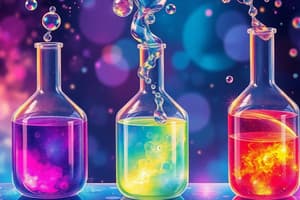Podcast
Questions and Answers
How does the dissociation constant (Ka) influence the buffering capacity of a solution?
How does the dissociation constant (Ka) influence the buffering capacity of a solution?
A higher Ka value indicates a stronger buffer action, allowing the solution to better resist changes in pH.
What happens to the equilibrium of an acidic buffer when an acid is added to the solution?
What happens to the equilibrium of an acidic buffer when an acid is added to the solution?
The equilibrium shifts to the left to decrease the concentration of H+ ions by forming more undissociated acid molecules.
Describe the effect on a basic buffer when H+ ions are introduced.
Describe the effect on a basic buffer when H+ ions are introduced.
H+ ions react with OH- ions released by ammonia, causing the equilibrium to shift to the right to replace the consumed OH- ions.
In the context of buffering solutions, explain the role of conjugate bases and weak acids.
In the context of buffering solutions, explain the role of conjugate bases and weak acids.
Why are buffers considered essential in chemical reactions and biological systems?
Why are buffers considered essential in chemical reactions and biological systems?
What is entropy a measure of in a system?
What is entropy a measure of in a system?
How does the dissolution of a solid affect the entropy of a system?
How does the dissolution of a solid affect the entropy of a system?
What does an increase in entropy imply about the stability of a system?
What does an increase in entropy imply about the stability of a system?
What information does Gibbs free energy provide about a reaction?
What information does Gibbs free energy provide about a reaction?
Define a conjugate acid-base pair.
Define a conjugate acid-base pair.
Why can the formula for pH only be applied to weak acids?
Why can the formula for pH only be applied to weak acids?
What does the acid dissociation constant (Ka) indicate about an acid?
What does the acid dissociation constant (Ka) indicate about an acid?
How does the equilibrium position of weak acids generally behave?
How does the equilibrium position of weak acids generally behave?
Why is the lattice enthalpy of ionic compounds always exothermic when forming a solid from gaseous ions?
Why is the lattice enthalpy of ionic compounds always exothermic when forming a solid from gaseous ions?
How does ionic charge affect the lattice formation enthalpy?
How does ionic charge affect the lattice formation enthalpy?
What role does ionic radius play in lattice enthalpy?
What role does ionic radius play in lattice enthalpy?
Explain the significance of an endothermic ΔH atomization.
Explain the significance of an endothermic ΔH atomization.
What is the first electron affinity and how is it represented?
What is the first electron affinity and how is it represented?
What factors influence the strength of electron affinity?
What factors influence the strength of electron affinity?
Why is only the first electron affinity exothermic?
Why is only the first electron affinity exothermic?
What is the difference between standard conditions and standard temperature and pressure (STP)?
What is the difference between standard conditions and standard temperature and pressure (STP)?
Why are the second and third electron affinities considered endothermic?
Why are the second and third electron affinities considered endothermic?
What trend occurs in the electron affinity (EA1) of Group 16 elements as you move down the group?
What trend occurs in the electron affinity (EA1) of Group 16 elements as you move down the group?
Why does fluorine have a lower EA1 than chlorine despite being higher in the periodic table?
Why does fluorine have a lower EA1 than chlorine despite being higher in the periodic table?
How does hydration enthalpy relate to the size of ions?
How does hydration enthalpy relate to the size of ions?
Explain the relationship between the charge of an ion and its hydration enthalpy.
Explain the relationship between the charge of an ion and its hydration enthalpy.
What is the primary reason for the trend of decreasing hydration enthalpy down a group in the Periodic Table?
What is the primary reason for the trend of decreasing hydration enthalpy down a group in the Periodic Table?
Describe the role of water molecules in the hydration of ions.
Describe the role of water molecules in the hydration of ions.
What is the significance of the term 'exothermic' in the context of electron affinity and hydration enthalpy?
What is the significance of the term 'exothermic' in the context of electron affinity and hydration enthalpy?
What is the Henderson-Hasselbalch equation used for?
What is the Henderson-Hasselbalch equation used for?
Explain how an amphoteric buffer behaves in the presence of an acid.
Explain how an amphoteric buffer behaves in the presence of an acid.
What keeps human blood pH between 7.35 and 7.45?
What keeps human blood pH between 7.35 and 7.45?
What is the significance of Ksp in solubility product calculations?
What is the significance of Ksp in solubility product calculations?
How does the common ion effect influence the solubility of a salt?
How does the common ion effect influence the solubility of a salt?
Outline the steps to determine if a precipitate will form in a saturated solution.
Outline the steps to determine if a precipitate will form in a saturated solution.
What reaction occurs when a base reacts with an amphoteric buffer?
What reaction occurs when a base reacts with an amphoteric buffer?
What does a Ksp value of 1x10^-14 indicate regarding the pH of water?
What does a Ksp value of 1x10^-14 indicate regarding the pH of water?
Flashcards
Lattice Dissociation Enthalpy
Lattice Dissociation Enthalpy
The energy required to break 1 mole of an ionic compound into its gaseous ions under standard conditions.
Lattice Formation Enthalpy
Lattice Formation Enthalpy
The energy released when 1 mole of gaseous ions combine to form 1 mole of an ionic compound under standard conditions.
Relationship between Lattice Enthalpy and Ionic Attraction
Relationship between Lattice Enthalpy and Ionic Attraction
The greater the attraction between ions within the lattice, the more negative the lattice formation enthalpy.
Effect of Ionic Charge on Lattice Enthalpy
Effect of Ionic Charge on Lattice Enthalpy
Signup and view all the flashcards
Effect of Ionic Radius on Lattice Enthalpy
Effect of Ionic Radius on Lattice Enthalpy
Signup and view all the flashcards
First Electron Affinity (EA1)
First Electron Affinity (EA1)
Signup and view all the flashcards
Effect of Nuclear Charge on Electron Affinity
Effect of Nuclear Charge on Electron Affinity
Signup and view all the flashcards
Effect of Shielding on Electron Affinity
Effect of Shielding on Electron Affinity
Signup and view all the flashcards
Electron affinity (EA1)
Electron affinity (EA1)
Signup and view all the flashcards
Second or third electron affinity
Second or third electron affinity
Signup and view all the flashcards
Electron affinity trend down a group
Electron affinity trend down a group
Signup and view all the flashcards
Hydration enthalpy
Hydration enthalpy
Signup and view all the flashcards
Factors affecting hydration enthalpy
Factors affecting hydration enthalpy
Signup and view all the flashcards
Size of the ion
Size of the ion
Signup and view all the flashcards
Charge of the ion
Charge of the ion
Signup and view all the flashcards
Dissolving ionic solids in water
Dissolving ionic solids in water
Signup and view all the flashcards
Buffer solution
Buffer solution
Signup and view all the flashcards
Acidic Buffer
Acidic Buffer
Signup and view all the flashcards
Acidic buffer reaction to acid addition
Acidic buffer reaction to acid addition
Signup and view all the flashcards
Basic Buffer
Basic Buffer
Signup and view all the flashcards
Basic buffer reaction to base addition
Basic buffer reaction to base addition
Signup and view all the flashcards
Entropy (S)
Entropy (S)
Signup and view all the flashcards
Equilibrium
Equilibrium
Signup and view all the flashcards
Gibbs Free Energy (G)
Gibbs Free Energy (G)
Signup and view all the flashcards
Acid Dissociation Constant (Ka)
Acid Dissociation Constant (Ka)
Signup and view all the flashcards
Conjugate Acid-Base Pair
Conjugate Acid-Base Pair
Signup and view all the flashcards
pH
pH
Signup and view all the flashcards
Spreading Out of Particles
Spreading Out of Particles
Signup and view all the flashcards
Spontaneous Processes
Spontaneous Processes
Signup and view all the flashcards
Henderson-Hasselbalch Equation
Henderson-Hasselbalch Equation
Signup and view all the flashcards
Amphoteric Buffer
Amphoteric Buffer
Signup and view all the flashcards
Blood Buffer System
Blood Buffer System
Signup and view all the flashcards
Ionic Product of Water (Kw)
Ionic Product of Water (Kw)
Signup and view all the flashcards
Solubility
Solubility
Signup and view all the flashcards
Solubility Product (Ksp)
Solubility Product (Ksp)
Signup and view all the flashcards
Common Ion Effect
Common Ion Effect
Signup and view all the flashcards
Predicting Precipitate Formation
Predicting Precipitate Formation
Signup and view all the flashcards
Study Notes
Chemical Energetics
- Atomisation enthalpy (ΔHat): The enthalpy change when one mole of gaseous atoms is formed from the element in its standard state. ΔHat is always positive (endothermic).
- Lattice dissociation enthalpy: The enthalpy change needed to convert one mole of solid crystal into its scattered gaseous ions. Lattice dissociation enthalpies are always positive (endothermic).
- Lattice formation enthalpy: The enthalpy change when one mole of solid crystal is formed from its scattered gaseous ions. Lattice formation enthalpies are always negative (exothermic).
- Ionic bonds are strong: When ions combine to form an ionic solid lattice, a large amount of energy is released.
- Ionic compounds are stable. The strong electrostatic forces of attraction between oppositely charged ions make ionic compounds more stable than their gaseous ions.
Factors Affecting Lattice Enthalpy
- Ionic charge: Increasing the ionic charge increases the attraction between the ions, leading to a larger, more negative lattice enthalpy.
- Ionic radius: Decreasing the ionic radius brings the ions closer together, increasing the attraction and leading to a larger, more negative lattice enthalpy.
- Charge density: Both ionic charge and ionic radius affect charge density. A higher charge density results in a greater lattice enthalpy.
Electron Affinity
- First electron affinity (EA₁): The enthalpy change when one mole of electrons is added to one mole of gaseous atoms to form one mole of gaseous ions each with a single negative charge. The first electron affinity is typically exothermic (negative) for most elements.
- Factors affecting EA:
- Nuclear charge: An increase in nuclear charge increases the attraction between the nucleus and the incoming electron, resulting in larger, more negative affinities.
- Distance: A greater distance between the nucleus and the outermost electron shell/orbital weakens the attraction, resulting in lower, less negative affinities.
- Shielding: More electron shells increase the shielding effect, reducing the attraction and subsequently decreasing the electron affinity.
Trends in Electron Affinity of Group 16 & 17 Elements
- General trend: Moving down a group, EA₁ becomes less exothermic due to increased atomic size, greater distance between the nucleus and the outermost electron, and greater shielding.
- Fluorine exception: Fluorine has a lower EA₁ than chlorine due to its very small atomic radius resulting in high electron density, and therefore greater repulsion between the incoming electron and existing electrons.
Enthalpy Changes (Table of Definitions)
- A table including various enthalpy changes, such as formation, neutralisation, combustion, enthalpy of atomisation, ionisation enthalpy, hydration enthalpy, etc. along with their respective thermodynamic signs (positive or negative).
Enthalpy of Solution and Hydration
- Enthalpy of solution: The enthalpy change when one mole of an ionic substance dissolves in water to give a solution of infinite dilution.
- Hydration enthalpy: The enthalpy change when one mole of gaseous ions dissolves in sufficient water to give an infinitely dilute solution. Hydration enthalpy is always negative.
- Attraction between ions and water: When an ionic solid dissolves, positive and negative ions are formed in water. Water molecules form ion-dipole attractions with these ions.
Entropy
- Entropy (S): A measure of disorder in a system. Increasing disorder results in increased entropy, making the system energetically more stable.
- Gas > Liquid > Solid: Gases have the highest entropy, followed by liquids and then solids.
- Temperature change: Entropy generally increases with increasing temperature as the particles gain more energy and disorder increases.
- Change in state: Phase transitions (melting, vaporization, etc.) generally increase entropy. Dissolving a solid into a liquid, increases the entropy.
Gibbs Free Energy
- Gibbs free energy (ΔG): A measure of spontaneity. ΔG = ΔH - TΔS.
- If ΔG is negative, the reaction is spontaneous at that particular temperature.
- If ΔG is positive, the reaction is nonspontaneous at that particular temperature.
- Temperature change and feasibility: A reaction that is not feasible at low temperatures may become feasible at higher temperatures, or vice versa, depending on the relative enthalpy and entropy changes.
- Units of ΔG, ΔH, and ΔS are crucial.
Equilibria
- Conjugate acid-base pair: Compounds that differ by one proton.
- pH: The negative logarithm of the hydrogen ion concentration.
- pOH: The negative logarithm of the hydroxide ion concentration.
Acid Dissociation Constant (Ka)
- Ka: measure of the extent of dissociation of a weak acid; the smaller the Ka the weaker the acid.
Acidic Buffers
- Buffer solutions: Resist changes in pH when small quantities of acid or alkali are added.
- How Ka relates to buffer action: A buffer with a higher Ka value has greater resistance to pH change than a buffer with a lower Ka value.
Basic Buffers
- Buffer solutions: Resist changes in pH when small quantities of acid or alkali are added.
- How Ka relates to buffer action: A buffer with a higher Ka value has greater resistance to pH change than a buffer with a lower Ka value.
Amphoteric Buffers
- Amphoteric substances: Substancdes that can act as both acids and bases.
- Amino acids in blood: The amino and carboxyl groups in amino acids often act as acids and bases to maintain the blood pH.
- Carbonic acid/ bicarbonate buffer in blood: These two components buffer changes in blood pH.
Electrochemistry
- Methods for predicting substances liberated during electrolysis from various factors such as electrolyte state (molten or aqueous), redox series (electrode potential), and concentration.
- Balancing Redox half equations Details of steps in balancing atoms, water molecules, protons and electrons when balancing redox reactions in different scenarios.
Solubility Product (Ksp)
- Solubility Product (Ksp): A measure of the solubility of a sparingly soluble salt in water. A large Ksp means that the salt is more soluble.
- Sparingly Soluble Salts: Salts that dissolve only slightly in water.
- Common Ion Effect: Addition of a common ion to a saturated solution decreases the solubility of the salt.
Partition Coefficients
- Partition coefficient (Kpc): The ratio of concentrations of a solute in two immiscible solvents at equilibrium. The higher the Kpc, the greater the solute's solubility in the organic solvent.
- Factors affecting solubility.
Studying That Suits You
Use AI to generate personalized quizzes and flashcards to suit your learning preferences.




